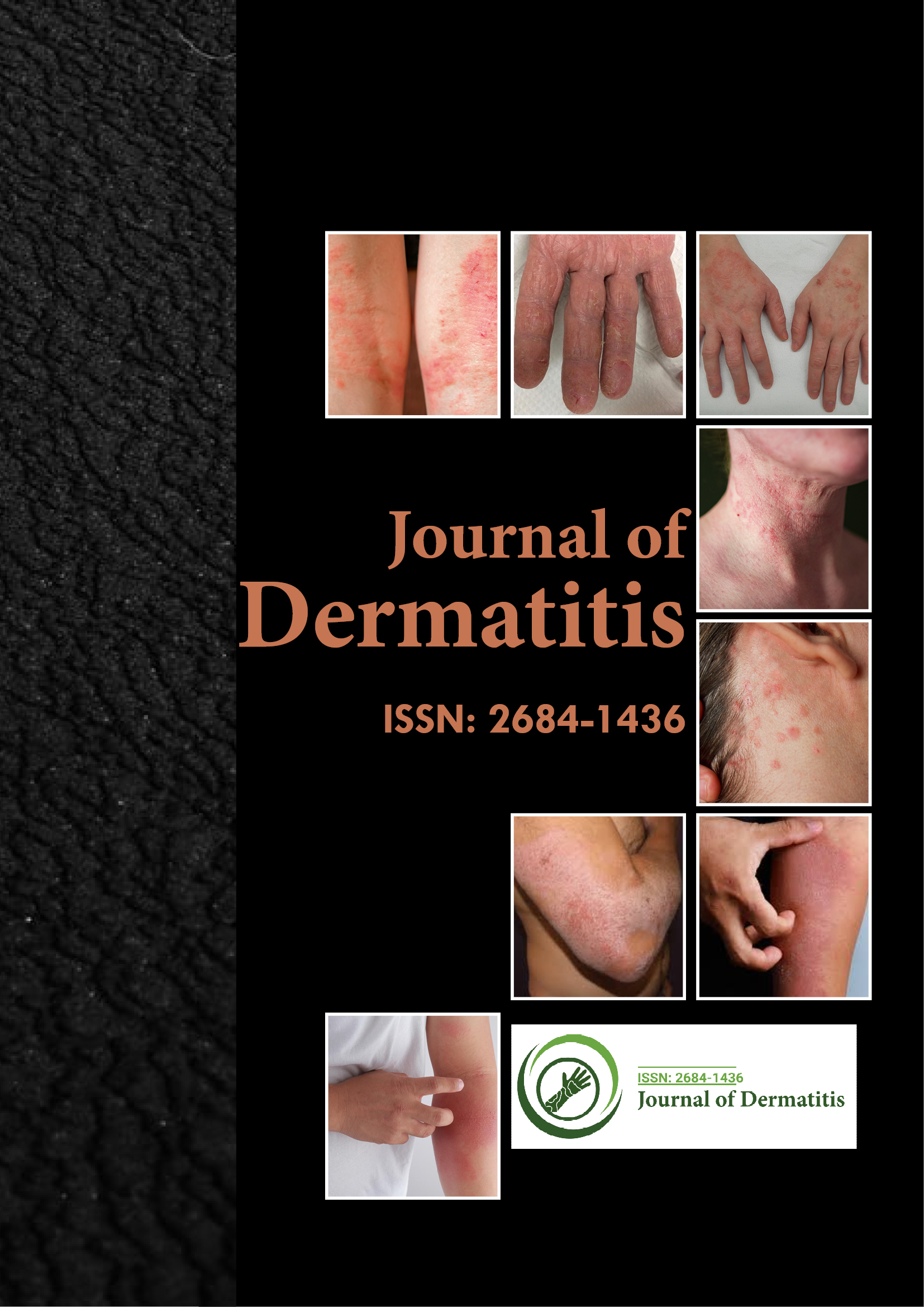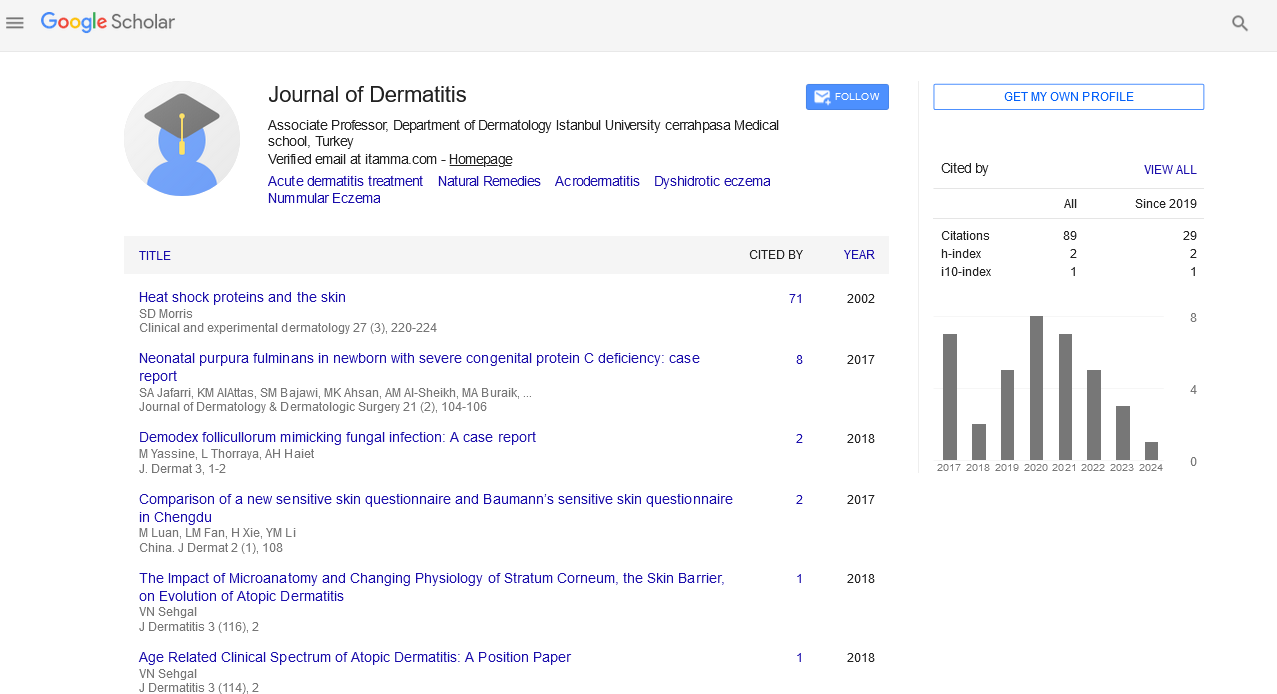Indexed In
- RefSeek
- Hamdard University
- EBSCO A-Z
- Euro Pub
- Google Scholar
Useful Links
Share This Page
Journal Flyer

Open Access Journals
- Agri and Aquaculture
- Biochemistry
- Bioinformatics & Systems Biology
- Business & Management
- Chemistry
- Clinical Sciences
- Engineering
- Food & Nutrition
- General Science
- Genetics & Molecular Biology
- Immunology & Microbiology
- Medical Sciences
- Neuroscience & Psychology
- Nursing & Health Care
- Pharmaceutical Sciences
Commentary - (2019) Volume 4, Issue 1
Diagnosing Lanolin Contact Allergy with Lanolin Alcohol and Amerchol L101
Jannet Knijp*Received: 05-Nov-2019 Published: 05-Dec-2019
Abstract
Lanolin contact allergy is frequently seen in referred dermatitis patients. It is a clinical problem, especially for those using lanolin containing topical medicaments. Lanolin alcohol 30% PET is the standard patch test agent for diagnosing lanolin contact allergy. However, supplementary patch testing with other lanolin derivatives seems to improve the identification of lanolin-sensitive patients. Particular attention is paid to Amerchol L101 50% PET., a mixture of 10% lanolin alcohols and mineral oil. The aim of this study was to determine which combination of lanolin derivatives is most effective in patch testing for diagnosing lanolin contact allergy.
Keywords
Lanolin alcohol; Contact allergy; Atopic dermatitis; Amerchol L101
Methods
A retrospective analysis of patients patch tested between 2016 and 2017 was performed. Patients were eligible if tested with lanolin alcohol 30% PET., Amerchol L101 50% PET. and a supplementary series containing other lanolin derivatives (e.g. cetearyl alcohol, adeps lanae, and Eucerin). Lanolin alcohol and Amerchol L101 were tested in duplicate [1-3].
Results
Out of 594 patients, 28.6% (95% Confidence Interval [CI]: 25.1%-32.3%) had a positive patch test reaction to at least one lanolin derivative. Patients with atopic dermatitis were more likely to have lanolin contact allergy (p=0.008, OR 1.75, 95% CI: 1.16-2.63) and patients with an age of = 40 years were less likely to have lanolin contact allergy (p=0.007, OR 0.57, 95% CI: 0.38-0.86) [4,5]. The highest prevalence of positive reactions was observed for both lanolin alcohol (14.7%, 95% CI: 11.3%-18.2%) and Amerchol L101 (15.0%, 95% CI: 11.5%-18.5%). The addition of Amerchol L101 to lanolin alcohol significantly increased the number of positive cases (odds ratio 1.79, p<0.001). Reactions to other test preparations were less frequent (p<0.05) [6,7].
Discussion
We confirmed that adding Amerchol L101 to lanolin alcohol in routine patch testing has an additional diagnostic value in detecting lanolin contact allergy [2,4,5,8]. We reported a higher prevalence of patients with lanolin contact allergy (28.6%, 95% CI: 25.1%-32.3%) than normally reported [3,5,7,9,11]. Our study population consisted of patients with a high suspicion of lanolin contact allergy, as they were selected to be additionally tested with lanolin derivatives. Moreover, the patients were referred for tertiary care. The positive association between atopic dermatitis and lanolin contact allergy has previously been reported [7,10,11]. The association between an age of <40 years and lanolin contact allergy was not in line with the literature, as previous studies reported a positive association between higher age and lanolin contact allergy [3,7]. The patch test concentration and/or the vehicle of some lanolin derivatives are not perfect. In addition, the relevance of a positive patch test reaction to lanolin can be difficult to establish. Further research is necessary to improve the patch test concentration of lanolin derivatives and better define the clinical relevance of positive patch tests.
Conclusions
Lanolin alcohol and Amerchol L101 is an effective combination of patch test preparations for diagnosing lanolin contact allergy.
Recommendations
We recommend adding Amerchol L101 to lanolin alcohol in routine patch testing, as it has an additional diagnostic value in detecting lanolin contact allergy. As other lanolin derivatives contributed to only a few additional positive cases, it may not be worthwhile to use them routinely for diagnosing lanolin contact allergy, but only in selected patients.
REFERENCES
- Bindslev Jensen C. Skin Tests for Immediate Hypersensitivity. In: Johansen JD, Frosch PJ, Lepoittevin LP (Eds). Contact dermatitis. (5th edn). Springer, Germany, 2011: pp: 511-520.
- Lee B, Warshaw E. Lanolin allergy: History, epidemiology, responsible allergens, and management. Dermatitis. 2008;19(2):63-72.
- Wakelin SH, Smith H, White IR, Rycroft RJ, Mcfadden JP. A retrospective analysis of contact allergy to lanolin. Br J Dermatol. 2001;145(1):28-31.
- Matthieu L, Dockx P. Discrepancy in patch test results with wool wax alcohols and Amerchol L-101. Contact Dermatitis. 1997; 36(3):150-151.
- Miest RY, Yiannias JA, Chang YH, Singh N. Diagnosis and prevalence of lanolin allergy. Dermatitis. 2013;24(3):119-123.
- Mortensen T. Allergy to lanolin. Contact Dermatitis. 1979;5(3):137-139.
- Fransen M, Overgaard LEK, Johansen JD, Thyssen JP. Contact allergy to lanolin: Temporal changes in prevalence and association with atopic dermatitis. Contact Dermatitis. 2018;78(1):70-75.
- Uter W, Schnuch A, Geier J, IVDK. Contact sensitization to lanolin alcohols and Amerchol® L101: Analysis of IVDK data. Contact Dermatitis. 2018;78(5):367-369.
- Trummer M, Aberer W, Kränke B. Clinical relevance of + patch test reactions to lanolin alcohol. Contact Dermatitis. 2002;46(2):118.
- Lubbes S, Rustemeyer T, Sillevis Smitt JH, Schuttelaar ML, Middelkamp-Hup MA. Contact sensitization in Dutch children and adolescents with and without atopic dermatitis: A retrospective analysis. Contact Dermatitis. 2017;76(3):151-159.
- Warshaw EM, Nelsen DD, Maibach HI, Marks JG, Zug KA, Taylor JS, et al. Positive patch test reactions to lanolin: cross-sectional data from the north american contact dermatitis group, 1994 to 2006. Dermatitis. 2009;20(2):79-88.
Citation: Jannet Knijp (2019) Diagnosing Lanolin Contact Allergy with Lanolin Alcohol and Amerchol L101. J Dermatitis.4:118. DOI: 10.35248/2684-1436.19.1.118.
Copyright: © 2019 Knijp J, et al. This is an open-access article distributed under the terms of the Creative Commons Attribution License, which permits unrestricted use, distribution, and reproduction in any medium, provided the original author and source are credited.

